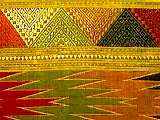 LAOS--Part 1
LAOS--Part 1
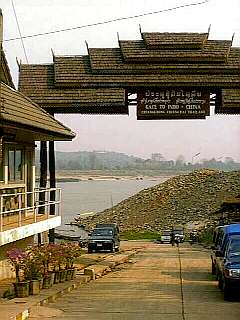 The
trip through the countryside from Chiang Rai to Chiang Khong in northern Thailand
was an uncomfortable one, though scenic -- while the landscape is beautiful,
farmers were setting fires everywhere to prepare their fields for planting
before the rainy seasons starts a couple of months from now. The smoke was
THICK. I was glad when we got to Chiang Khong to see the mighty Maekhong (Mekong)
River, and Laos on the other side. This sign announced our near-arrival into
a new region within Southeast Asia, "Indo-China" -- the part the French colonized,
which includes Lao, Vietnam and Cambodia. ("Lao" is increasingly becoming
recognized as the appropriate name for the country, by the way, rather than
"Laos", which is based on a mis-reading by the French.) I never really thought
before about that term, "Indo-China", and how it indicates this is an area
right on the cusp between Indian and Chinese influences.
The
trip through the countryside from Chiang Rai to Chiang Khong in northern Thailand
was an uncomfortable one, though scenic -- while the landscape is beautiful,
farmers were setting fires everywhere to prepare their fields for planting
before the rainy seasons starts a couple of months from now. The smoke was
THICK. I was glad when we got to Chiang Khong to see the mighty Maekhong (Mekong)
River, and Laos on the other side. This sign announced our near-arrival into
a new region within Southeast Asia, "Indo-China" -- the part the French colonized,
which includes Lao, Vietnam and Cambodia. ("Lao" is increasingly becoming
recognized as the appropriate name for the country, by the way, rather than
"Laos", which is based on a mis-reading by the French.) I never really thought
before about that term, "Indo-China", and how it indicates this is an area
right on the cusp between Indian and Chinese influences.
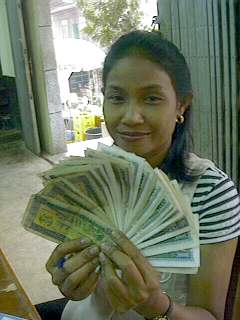 The
first thing you do when you get into any new country is exchange some of your
money for the local currency. In Lao, it's even more bizarre than what I showed
you in Myanmar, because the biggest bill is a 5000-kip note -- which
is worth about seventy-five cents! (And even THOSE are hard to find...) The
lovely woman in this photo is holding up a wad of cash worth well over --
SIX whole dollars. WOW! I can't imagine what I'll do when I have to change
a hundred dollars at one time; maybe I'll just borrow a wheelbarrow to cart
around all my cash. (See my Expense Log to get
a sense of what things cost on the road.)
The
first thing you do when you get into any new country is exchange some of your
money for the local currency. In Lao, it's even more bizarre than what I showed
you in Myanmar, because the biggest bill is a 5000-kip note -- which
is worth about seventy-five cents! (And even THOSE are hard to find...) The
lovely woman in this photo is holding up a wad of cash worth well over --
SIX whole dollars. WOW! I can't imagine what I'll do when I have to change
a hundred dollars at one time; maybe I'll just borrow a wheelbarrow to cart
around all my cash. (See my Expense Log to get
a sense of what things cost on the road.)
 This
post office in Huay Xai is like a mini-lesson in Lao political history of
the past century and more. The sign is written in French, a reminder of the
fact that Lao gained independence from colonial rule by France only fifty
years ago. The red flag with hammer and sickle is the international symbol
of Communism; next to it (and behind the sign) is the Lao national flag. These
two together reflect the past fifty years of Lao's history, during which the
present Communist-led government (controlled by the LPRP, or Lao People's
Revolutionary Party) gained power through constant struggle and war. That
fighting included the "Secret War" waged by the United States and its allies
in the 1960's and 1970's, which I'll talk about in detail later.
This
post office in Huay Xai is like a mini-lesson in Lao political history of
the past century and more. The sign is written in French, a reminder of the
fact that Lao gained independence from colonial rule by France only fifty
years ago. The red flag with hammer and sickle is the international symbol
of Communism; next to it (and behind the sign) is the Lao national flag. These
two together reflect the past fifty years of Lao's history, during which the
present Communist-led government (controlled by the LPRP, or Lao People's
Revolutionary Party) gained power through constant struggle and war. That
fighting included the "Secret War" waged by the United States and its allies
in the 1960's and 1970's, which I'll talk about in detail later.
But the ride WAS beautiful. We passed by newly-planted terraces of rice, and through primordial jungle full of trees covered with beehives. Just after the dust storm incident, we drove through a dense cloud of butterflies! And all along, we passed by village after village of simple, yet beautiful, stilt houses. The houses in each village were a bit different in style (especially in the railings along their front "balconies"), but all were made completely of wood and blended in perfectly with the scenery. Even the temples were simple wooden structures, except for two we saw that stood out dramatically because of their colorful, Thai-style architecture.
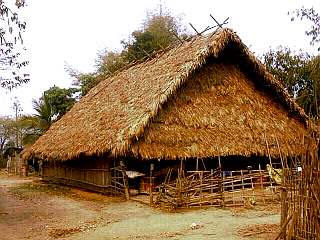 After
the first leg of our ride, we arrived at a village of the Lenten tribe named
Ban Nam Chang. The Lenten originally lived in Mongolia, but were kicked out
long ago by one of Genghis Khan's grandchildren. After stopping in Tibet for,
oh, a couple hundred years, they made their way eventually to Lao. Throughout
those years of travel, they have kept many of their ancient ways and traditions,
such as living in multi-family longhouses like this one...
After
the first leg of our ride, we arrived at a village of the Lenten tribe named
Ban Nam Chang. The Lenten originally lived in Mongolia, but were kicked out
long ago by one of Genghis Khan's grandchildren. After stopping in Tibet for,
oh, a couple hundred years, they made their way eventually to Lao. Throughout
those years of travel, they have kept many of their ancient ways and traditions,
such as living in multi-family longhouses like this one... ...and
building altars inside to worship their ancestors and the spirits of village,
sky, forest, earth, water and birds. They mix this animism with Taoism
as well, which reflects their Chinese history, and the Chinese writing you
can see on the altar provides further proof of their origins to the north.
...and
building altars inside to worship their ancestors and the spirits of village,
sky, forest, earth, water and birds. They mix this animism with Taoism
as well, which reflects their Chinese history, and the Chinese writing you
can see on the altar provides further proof of their origins to the north.
 We
were invited into the headman's house, where his wife was preparing cotton
for spinning. She would take the raw cotton, its seeds already picked out,
and place it around the taut metal string of this "fluffing" tool. When she
struck the string with a wooden mallet, the cotton would be fluffed out into
a form better suited for spinning. The "ping"ing sound that resulted could
be heard coming from houses all around the village.
We
were invited into the headman's house, where his wife was preparing cotton
for spinning. She would take the raw cotton, its seeds already picked out,
and place it around the taut metal string of this "fluffing" tool. When she
struck the string with a wooden mallet, the cotton would be fluffed out into
a form better suited for spinning. The "ping"ing sound that resulted could
be heard coming from houses all around the village.
 Here,
the headman's mother is spinning the cotton into thread on a traditional wheel.
The women of the village then dye the thread with indigo (which is
made by boiling the leaves of a plant easily found locally) and weave the
threads into the Lentens' characteristic blue fabric that you can see her
and her daughter-in-law (the "fluffer") wearing. The women also pluck their
eyebrows at the age of fifteen, and (you can't see it very well here) wear
a coin tucked into the part of their long black hair.
Here,
the headman's mother is spinning the cotton into thread on a traditional wheel.
The women of the village then dye the thread with indigo (which is
made by boiling the leaves of a plant easily found locally) and weave the
threads into the Lentens' characteristic blue fabric that you can see her
and her daughter-in-law (the "fluffer") wearing. The women also pluck their
eyebrows at the age of fifteen, and (you can't see it very well here) wear
a coin tucked into the part of their long black hair.
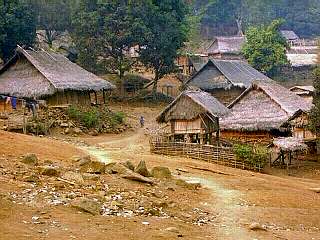 The
second village we visited was straight up into the mountains, and only accessible
by a four-wheel-drive vehicle. It was much lager than the Lenten village,
with over four hundred people living inside its boundaries. This was a Hmong
village called Huay Xa La. The people of this village share their homes with
the chickens, goats and pigs they raise. In the valleys nearby, they farm
vegetables like corn, rice and potatoes...
The
second village we visited was straight up into the mountains, and only accessible
by a four-wheel-drive vehicle. It was much lager than the Lenten village,
with over four hundred people living inside its boundaries. This was a Hmong
village called Huay Xa La. The people of this village share their homes with
the chickens, goats and pigs they raise. In the valleys nearby, they farm
vegetables like corn, rice and potatoes...
 ...and
hunt, as was this villager who was just leaving for his day's rounds as we
entered. In the forests live wild boar, deer and bear, all worthy targets
to the Hmong and prized for their meat, skin and bones (which make good tools).
...and
hunt, as was this villager who was just leaving for his day's rounds as we
entered. In the forests live wild boar, deer and bear, all worthy targets
to the Hmong and prized for their meat, skin and bones (which make good tools).
 The
villagers were extremely friendly, especially when they learned I'm a teacher
and have had several Hmong students in my classroom. (To learn more about
the story of why many Hmong people came to the U.S., click
here.) One boy invited me into his home, where he lives with
his mother, father, and six brothers and sisters. They have one bedroom for
the parents, and the rest all sleep on a raised platform in the main room.
Here you can see the kitchen area, which is set off to the side of the main
room. If you look carefully at the area above the fire pit, you can see hanging
bags full of cooking spices, an elephant bell, a wooden cowbell, two woodwind
musical instruments called khaens, and bamboo covers used to smoke
meats and fish.
The
villagers were extremely friendly, especially when they learned I'm a teacher
and have had several Hmong students in my classroom. (To learn more about
the story of why many Hmong people came to the U.S., click
here.) One boy invited me into his home, where he lives with
his mother, father, and six brothers and sisters. They have one bedroom for
the parents, and the rest all sleep on a raised platform in the main room.
Here you can see the kitchen area, which is set off to the side of the main
room. If you look carefully at the area above the fire pit, you can see hanging
bags full of cooking spices, an elephant bell, a wooden cowbell, two woodwind
musical instruments called khaens, and bamboo covers used to smoke
meats and fish.
 Outside
the house, a group of women were embroidering cloth using traditional patterns
of the Striped Hmong. (Other Hmong tribes are called Red, Black, White and
Green, which refer to particular characteristics of their clothing.) The more
colorful traditional clothing is saved these days to be worn only for special
ceremonies, like New Year's celebrations or funerals,...
Outside
the house, a group of women were embroidering cloth using traditional patterns
of the Striped Hmong. (Other Hmong tribes are called Red, Black, White and
Green, which refer to particular characteristics of their clothing.) The more
colorful traditional clothing is saved these days to be worn only for special
ceremonies, like New Year's celebrations or funerals,...
 ...or,
at least in part, to go to market. As we left Huay Xa La, we saw these women
returning from a day's trip to the nearest local market, having walked the
same distance it took us an hour to drive in our four-wheel-drive (over six
miles each way)!
...or,
at least in part, to go to market. As we left Huay Xa La, we saw these women
returning from a day's trip to the nearest local market, having walked the
same distance it took us an hour to drive in our four-wheel-drive (over six
miles each way)!
 On
the way back to Huay Xai, we passed by a school house to the side of the road.
While most students walk to the school, we found out, some come from longer
distances and ride their bikes.
On
the way back to Huay Xai, we passed by a school house to the side of the road.
While most students walk to the school, we found out, some come from longer
distances and ride their bikes.
 With
our guide translating, we were able to enter the school and ask some questions.
It turns out this is a junior high school, which in Lao covers grades six
to eight and includes students generally of ages twelve to fifteen. We arrived
on an "off-day" before the weekend, so that instead of having regular classes...
With
our guide translating, we were able to enter the school and ask some questions.
It turns out this is a junior high school, which in Lao covers grades six
to eight and includes students generally of ages twelve to fifteen. We arrived
on an "off-day" before the weekend, so that instead of having regular classes...
 ...the
students were holding an election for "class leader". This class leader takes
responsibility for assigning tasks to be done around the school, from cleaning
the blackboard to sweeping the floors to taking the garbage out to be burned.
I like their system of counting votes by fives using a square and slash --
it's a little different from the one I'm used to with four vertical lines
and a slash, and actually a little easier to read, I think. The writing on
the board also shows that fifty-six of the sixty-one (!) students enrolled
in this class were present on this particular day.
...the
students were holding an election for "class leader". This class leader takes
responsibility for assigning tasks to be done around the school, from cleaning
the blackboard to sweeping the floors to taking the garbage out to be burned.
I like their system of counting votes by fives using a square and slash --
it's a little different from the one I'm used to with four vertical lines
and a slash, and actually a little easier to read, I think. The writing on
the board also shows that fifty-six of the sixty-one (!) students enrolled
in this class were present on this particular day.
 At
sunrise the next day, we went to Huay Xai's morning market. It's not very
big, and looked like most other small-town markets I've shown you in other
Southeast Asian countries -- but I thought it was interesting how the butchers
stood behind fencing to serve the people waiting in line. I guess some people
REALLY like their meat (and might TAKE it if given the chance)!
At
sunrise the next day, we went to Huay Xai's morning market. It's not very
big, and looked like most other small-town markets I've shown you in other
Southeast Asian countries -- but I thought it was interesting how the butchers
stood behind fencing to serve the people waiting in line. I guess some people
REALLY like their meat (and might TAKE it if given the chance)!
 Above
the town stands Huay Xai's main temple complex, Wat Jawn Khao Manilat. As
in Thailand and Myanmar, Buddhism is the chief religion in Lao, and boys are
often ordained to become "monks-in-waiting" at a young age. These adolescent
disciples were working on a building project with the help(?) of a friend.
Actually, most of them were juggling stones off to the side of the work site,
but they'd scatter whenever I tried to take a photo.
Above
the town stands Huay Xai's main temple complex, Wat Jawn Khao Manilat. As
in Thailand and Myanmar, Buddhism is the chief religion in Lao, and boys are
often ordained to become "monks-in-waiting" at a young age. These adolescent
disciples were working on a building project with the help(?) of a friend.
Actually, most of them were juggling stones off to the side of the work site,
but they'd scatter whenever I tried to take a photo.
 Look
familiar? Back down at the river, I saw these bamboo cages that remind me
of the fishing done at Inle Lake in Myanmar. But these are different:
they're stationary (they stay in one place), and they're set up so that the
fish wander in and get stuck. You just check them every once in a while (like
at the end of the day) to see if you have a catch. Right now, these particular
cages are out of the water because it's the hot season and the river level
is very low, so that water is left only in the deepest part of the channel.
Even when the monsoons come and the water level rises a lot, these will be
in a relatively shallow part of the river -- and that's where they work best!
Look
familiar? Back down at the river, I saw these bamboo cages that remind me
of the fishing done at Inle Lake in Myanmar. But these are different:
they're stationary (they stay in one place), and they're set up so that the
fish wander in and get stuck. You just check them every once in a while (like
at the end of the day) to see if you have a catch. Right now, these particular
cages are out of the water because it's the hot season and the river level
is very low, so that water is left only in the deepest part of the channel.
Even when the monsoons come and the water level rises a lot, these will be
in a relatively shallow part of the river -- and that's where they work best!
With only a couple of weeks to get around as much of Lao as I could, I was itching to hit the road -- which, in this case, was the river. I ended up getting into a boat destined for Pakbeng, halfway to the next big city, Luang Prabang -- but not without an adventure. Read about that adventure:
|
Diary Entry: March 21, 1999 HIRING A BOAT, COME HIGH WATER -- OR HELL!(?) My guide book said it would be easy to go to the pier in Huay Xai and find a cargo boat willing to take passengers to Luang Prabang. This "slow boat" would be quiet and cheap, and while it would take two days to make the journey of two hundred kilometers, that would allow plenty of time to observe life along the river. (That may sound like a long time to go only a bit over a hundred miles, but going by road would have taken three full days of torturous driving over rutted dirt roads.) The alternative on the river was to take a speedboat, which the book advised to avoid at ALL costs: they go too fast to see anything, are about as noisy as a lawnmower might be if you were to mow your eyebrows, and for all that pain, they even cost more. Most important, though, they're dangerous, cruising at fifty miles per hour of faster even over rapids. Several people have died in recent years after being tossed out of speedboats and cracking open their skulls on the rocks -- and with the water level really low, and rocks jutting out of the water everywhere (or lurking just below the surface), the risk seemed even higher than usual. I showed up at the pier intent on finding that slow boat. Within a half hour, a dozen other people had shown up as well, all with the same idea. Unfortunately, we kept getting the same story: NO SLOW BOAT TODAY, you'll have to wait until Monday (two more days!), or take a speedboat today." "Why?!", we all asked, figuring they were just touts who'd make a few kip by steering us onto the death traps. "No government officials work on weekends to give you your official stamp (which you need when you arrive in a new province); we'll get in trouble." "But why can speedboats go, then?!", we asked in reply. No good answer. We waited and waited; several people gave up. Eventually, my friend and I decided to hire a speedboat and pay extra for the driver to go at half speed. I did NOT want to stay in Huay Xai another two days; on the other hand, I sure didn't want a cracked skull, either. This seemed like the best compromise. And, as you'll see in part 2, it was a good decision. |
Part 2: Along the Maekhong River